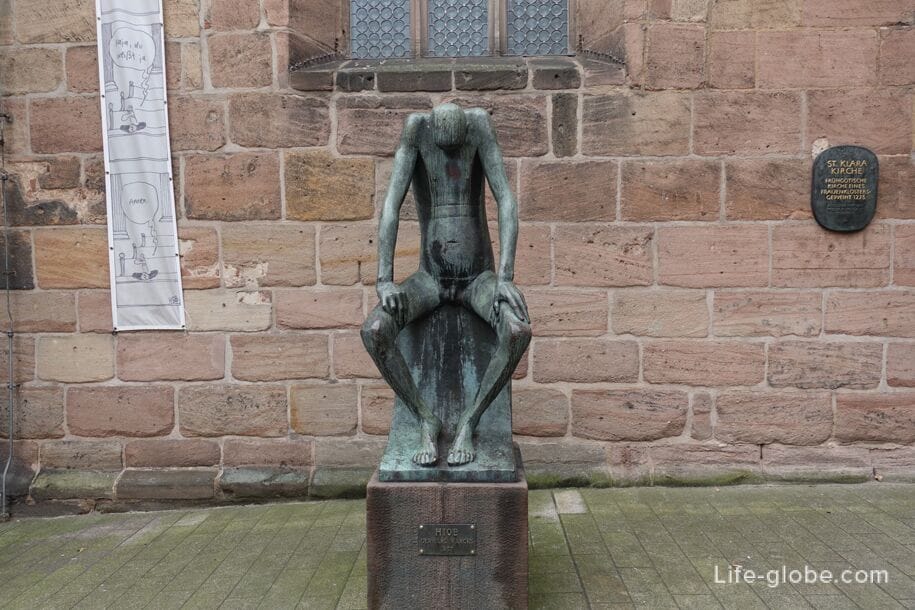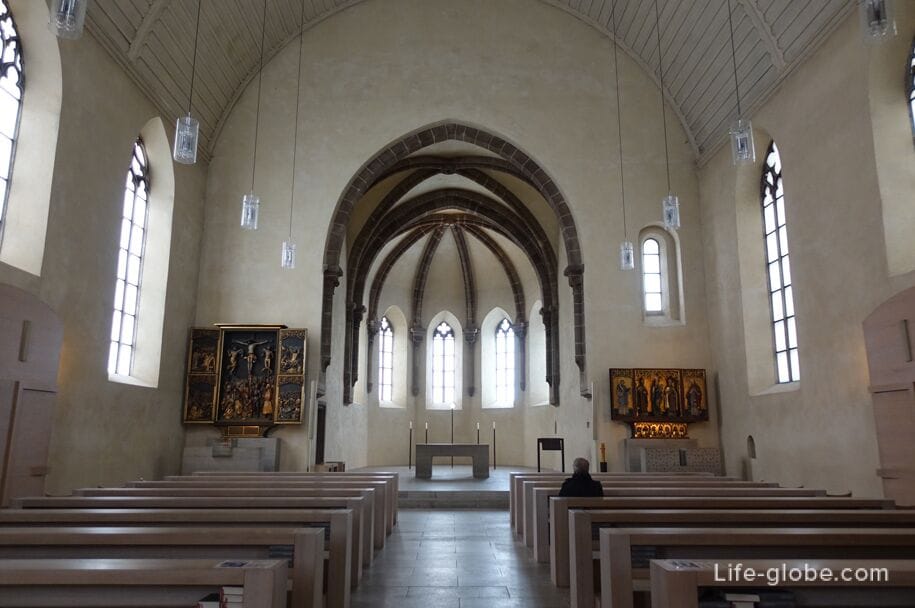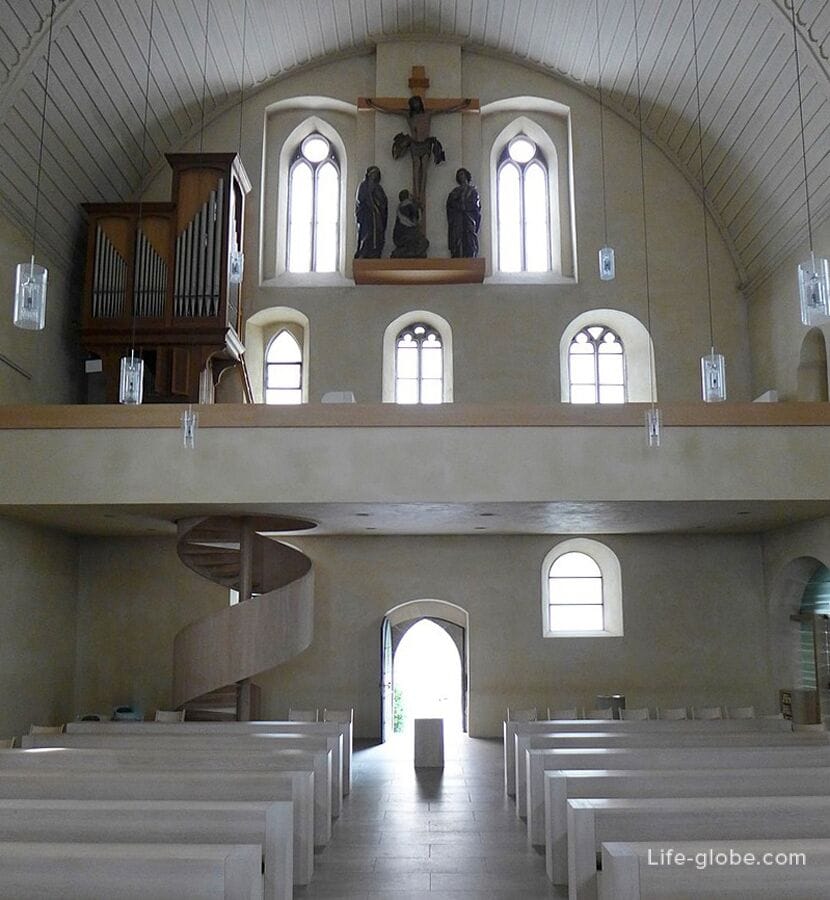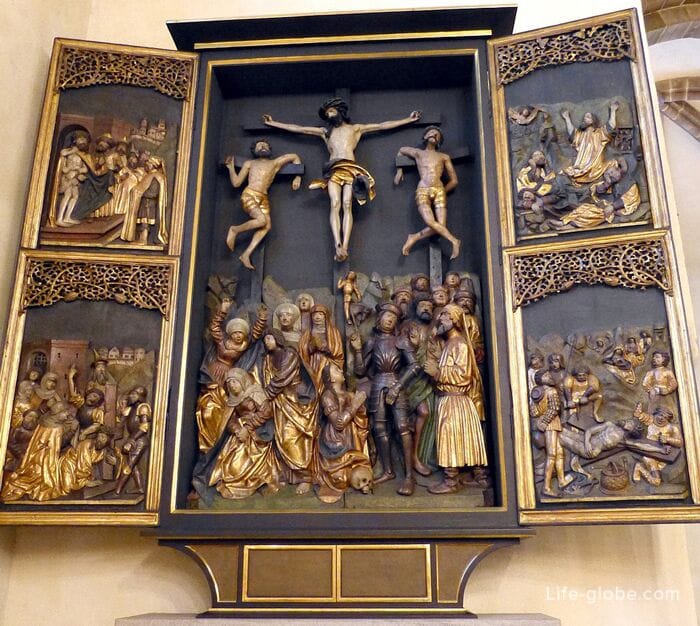
The Open Church of St. Clara (Offene Kirche St. Klara / St. Claire) or Klarakirche (Klarakirche) is a Roman Catholic church, which is one of the oldest preserved sacred buildings in Nuremberg.
The construction of the Romanesque-style church building was started in 1270. The consecration took place in 1274.
The building originally served as the church of the monastery of Poor Clara.
The expansion of the church was carried out in the first half of the 15th century. Then the church acquired a predominantly Gothic appearance.
After the reformation in 1525, the monastery was dissolved, and from 1574 the church was used as a Protestant preaching church.
When Nuremberg became part of Bavaria in 1806, the building of the shrine was desecrated. Since 1854, the shrine has again become a Catholic church.
The church was badly damaged by bombing during the Second World War. In the post-war period, it was restored to its former form.
Since 1996, St. Clare's Church has been an open church without a parish with a wide range of spiritual and cultural offerings and events.
In 2006 and 2007, the building was reconstructed, including: the entrance area, the altar and benches were replaced, as well as the heating and windows in the building were updated. The consecration of the altar took place on December 14, 2007.
Today, the architecture of St. Clare's Church appears to be predominantly a Gothic building with few Romanesque elements, for example, the arch of the main portal, the remains of the cornice, individual Romanesque arched windows.
The facade of the church is not decorated with anything, it is structured only by windows and flat buttresses at the corners of the polygonal choir. A prominent sacristy adjoins the choir section on the north side of the building.
The church lacks a tower, but there is a small roof turret on the west gable above the main portal.

Near the northern wall of the church, near the main portal, there is a remarkable bronze sculpture depicting the biblical righteous Job in the nude. The work of Gerhard Marx, 1957.


The interior of the one-nave church of St. Clare is made in strict and simple forms.

Of the works of art in the church are notable:
- a large carved group of the crucifixion of Christ, created by the Nuremberg sculptor and woodcarver Faith Wirsberger around 1510.
The group depicts: the crucified Jesus Christ, and the Mother of God, John and Mary Magdalene, kneeling at the foot of the cross;
- organ gallery and organ, which dates back to 1986;

- left side altar (located to the left of the choir) - a cross altar (Kreuzaltar) with filigree carved scenes of Passion, created in 1517 by an unknown master in the form of a triptych;

- the right side altar (located to the right of the choir) is the altar of Mary (Marienaltar), created in the form of a triptych and dating from about 1500.
Separate parts of the altar appeared in different centuries and were made by different masters, whose names are unknown.
In the center, the Virgin Mary is depicted standing in a halo on a crescent moon, with the baby Jesus in her left hand. Saint Nicholas the Wonderworker (of Myra) is depicted to the left of Mary (from the viewer's side) - in episcopal clothing and with a staff in his right hand, in his left hand he holds three balls - an attribute with which he is often depicted. To the right of the Mother is Pope Urban I, who has been revered as the patron saint of winemakers since the 15th century and, therefore, he is depicted with grapes in his hand as an attribute. He is also depicted with a staff and in episcopal vestments.
The inner part of the wings of the altar was designed at the end of the 19th century, they depict: St. Lawrence of Rome and the father of the church - Augustine Hippopotamus.
The Annunciation is depicted on the outside of the wings of the altar. The painting dates back to about 1522, its creator is also unknown.
The predella of the altar (the base) was made at the end of the 15th century and shows Christ surrounded by six apostles: Paul, James the Elder, Peter, John, Andrew and James the Younger.

In the church there is a small chapel (chapel), which was built as a successor to the lower part of the choir of the nuns in the early 15th century.
The chapel is named after the last abbess of the monastery of Clarisok - Caritas Pirkheimer.
During the restoration of the church in 2006 - 2007, the Pirkheimer chapel was transformed into an "entrance chapel" through which you can get to the church.
Also during the restoration work, the interior of the chapel was changed, the altar of Mary (Marienaltar) was built of glass and wooden elements, in the center of which there is a statue of the Madonna - a wooden sculpture of the Mother of God on a crescent and with a baby in her right hand, created at the end of the 15th century.

In the apse of the church is the grave of Caritas Pirkheimer.
In the spring of 2007, during renovation work on the north side of the choir of the church, the remains of a fresco were discovered showing scenes from Ezekiel's prophecy of the resurrection of the dead. The time of the fresco's creation is unknown for sure, but presumably - the 16th century.
Since the mural could not be reconstructed due to serious destruction, after analysis and documentation, a protective layer of plaster was applied to it. Today the mural is not visible.
The church has a Way of the Cross with 14 sculptural compositions, created by Martin von Feuerstein since 1929. The Way of the Cross was exhibited during the period of Easter penance.
St. Clara's Church is located in the southeastern part of the historic old town of Nuremberg, at 64 Königstrasse.
Website of the Church of St. Clara: st-klara-nuernberg.
All accommodation facilities in Nuremberg, including in the city center and near St. Clare's Church, can be viewed and booked here